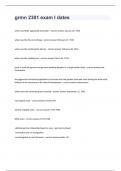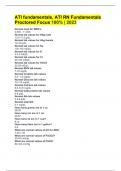NYSTCE Multi -Subject CST ELA ,Exam preview. 1005 Mastery, Easy Revision. Prereadin g - ✔✔-All knowledge, skills and experience that come before conventional literacy. Students gain oral vocabulary, learn sentence structure, develop phonological awareness Running record - ✔✔-An assessment which measures a child' fluency during oral readi ng Balanced Literacy Models - ✔✔-strategies teachers use to allow for different learning styles Phonological awareness - ✔✔-an awareness of an the ability to manipulate the sounds of spoken words; it is a broad term that includes identifying and making r hymes, recognizing alliteration, identifying and working with syllables in spoken words, identifying and working with onsets and rhymes in spoken syllables. Phoneme - ✔✔-in a spoken language, the smallest distinctive sound unit Phonemic Awareness - ✔✔-The ability to hear, identify,and manipulate the individual sounds, phonemes, in oral language. 5 Major Types of Tasks to develop Phonemic Awareness - ✔✔-1. Recognize sets of works have similar sounds (identifying rhyming words in a sentence) 2. Learn to ex amine a set of words to determine which is not like the others, oddity task) 3. Learn how to blend sounds to create words 4. Divide words into their phonemes (segmenting words) and count the number of sounds in a word 5. Learn how to manipulate the sounds in a word by substituting or deleting one or many phonemes Print Concept - ✔✔-Understanding how text works to communicate a message. Includes handing of books and orientation of text. Ways to facilitate print concepts - ✔✔-Combining movement activities t o convey bottom, top side. Teach the parts of a book. Experiences with different fonts and text sizes and the different meanings they have. Spacing. Writing exercises. Use of meta -language to descibe books. Track Print - ✔✔-student understands the direction of the text Alphabet Recognition - ✔✔-being able to identify the letters of the alphabet both capital and lowercase when asked to do so Alphabetic principle - ✔✔-the relationship between letters or combi nations of letters (graphemes) and sounds (phonemes) Letter -sound correspondence - ✔✔-refers to the identification of sounds associated with individual letters and letter combination. Short Vowel sounds - ✔✔-every vowel has two sounds, the vocal cords ar e more relaxed when producing the short vowel sound because of this the sounds are often referred to as lax. They can be heard at the beginning of these words: apple, Ed, igloo, octopus, and umbrella. Digraph - ✔✔-n. A union of two characters representing a single sound. Diphthong - ✔✔-n. The sound produced by combining two vowels in to a single syllable or running together the sounds. CVC - ✔✔-consonant -vowel -consonant pattern which produces a short vowel sound or a closed syllable. Consonant Clusters - ✔✔-- also called blends - Consonants that occur side by side within the same syllable. -No intervening vowel sound Phonics - ✔✔-teaching reading by training beginners to associate letters with their sound values Phonograms - ✔✔-Often called word famil ies, these end in high frequency rimes that vary only in the beginning consonant sound to make a word. For example, back, sack, black and track. Onset - ✔✔-the part of a syllable (or the one -syllable word) that comes before the vowel (e.g., str in string) Rime - ✔✔-The vowel and the ending consonants after the onset Semantic Cues - ✔✔-Use of knowledge about the subject of the text and words associated with that subject to identify an unknown word within a text: meaning cues from each sentence and the evolving whole. Children use their prior knowledge, sense of the st ory, and pictures to support their predicting and confirming the meaning of the text. Syntactic Cues - ✔✔-hints that rely on language structure or rules (sometimes called grammatical cues) Grammatical information in a text that readers process to construc t meaning. Content clues - ✔✔-surrounding words that help you figure out the meaning of unfamiliar words Syllabication - ✔✔-the ability to conceptualize and separate words into their basic pronunciation components. word structure - ✔✔-The way in which t he parts of a word are arranged together -used to determine a word's meaning syllabication rules - ✔✔-rules for forming/dividing words into syllables syllabication rules - ✔✔-. To find the number of syllables:Count the number of vowels (a, e, i, o, u and sometimes y) Subtract any silent vowels (vowel, consonant, -e) Subtract one vowel from every diphthong.(when two vowels go walking the first one does the talking)Divide between two double consonants. Never split between digraphs.Usually divide before a sin gle middle consonant.Divide before the consonant before -le syllable.Divide off any compound words, prefixes, suffixes and root which have vowel sounds. ALL syllables have a vowel compound words - ✔✔-Two or more words combined to create a new word. prefi x - ✔✔-a syllable or word that comes before a root word to change its meaning Suffix - ✔✔-a group of letters placed at the end of a word to change its meaning Inflectional suffixes - ✔✔-Indicate possession, gender, number in nouns, tense, voice, person & number & mood in verbs, and comparison in adjectives; do not change the part of speech of the base. ( -ed, -ing) Sight -word recognition - ✔✔-1. a word that is immediately recognized as a whole and does not require word analysis for identification. 2. a wo rd taught as a whole. Note: Words that are phonically irregular or are important to learn before students have the skills to decode them are often taught as sight words. Dolch List - ✔✔-A list of frequently used words compiled by Edward William Dolch, PhD , a major proponent of the "whole -word" method of beginning reading instruction. Goes up to 3rd grade Reading Fluency - ✔✔-ability to decode words quickly and accurately in order to read text with appropriate word stress, pitch, and intonation pattern (prosody).. This skill requires automacity of word recognition and reading with prosody to facilitate comp rehension. Vocabulary - ✔✔-a language user's knowledge of words. Important in Prereading activities. Use graphic organizers and word webs to introduce and review domain -Specific vocabulary words - ✔✔-Teacher discusses these when reading nonfiction in ord er to develop content clues






